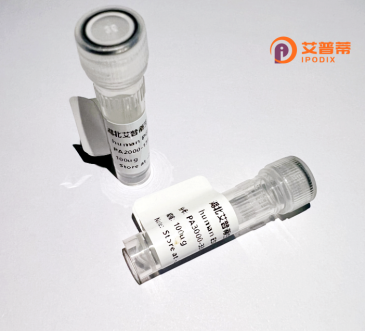
| 纯度 | >90%SDS-PAGE. |
| 种属 | Human |
| 靶点 | DLGAP4 |
| Uniprot No | Q9Y2H0 |
| 内毒素 | < 0.01EU/μg |
| 表达宿主 | E.coli |
| 表达区间 | 1-453aa |
| 氨基酸序列 | MALCLELLKQCSSCLVAYKKTPPPVPPRTTSKPFISVTVQSSTESAQDTYLDSQDHKSEVTSQSGLSNSSDSLDSSTRPPSVTRGGVAPAPEAPEPPPKHAALKSEQGTLTSSESHPEAAPKRKLSSIGIQVDCIQPVPKEEPSPATKFQSIGVQVEDDWRSSVPSHSMSSRRDTDSDTQDANDSSCKSSERSLPDCTPHPNSISIDAGPRQAPKIAQIKRNLSYGDNSDPALEASSLPPPDPWLETSSSSPAEPAQPGACRRDGYWFLKLLQAETERLEGWCCQMDKETKENNLSEEVLGKVLSAVGSAQLLMSQKFQQFRGLCEQNLNPDANPRPTAQDLAGFWDLLQLSIEDISMKFDELYHLKANSWQLVETPEKRKEEKKPPPPVPKKPAKSKPAVSRDKASDASDKQRQEARKRLLAAKRAASVRQNSATESADSIEIYVPEAQTRL |
| 分子量 | 75.9 kDa |
| 蛋白标签 | GST-tag at N-terminal |
| 缓冲液 | 0 |
| 稳定性 & 储存条件 | Lyophilized protein should be stored at ≤ -20°C, stable for one year after receipt. Reconstituted protein solution can be stored at 2-8°C for 2-7 days. Aliquots of reconstituted samples are stable at ≤ -20°C for 3 months. |
| 复溶 | Always centrifuge tubes before opening.Do not mix by vortex or pipetting. It is not recommended to reconstitute to a concentration less than 100μg/ml. Dissolve the lyophilized protein in distilled water. Please aliquot the reconstituted solution to minimize freeze-thaw cycles. |
以下为3篇关于重组人DLGAP4蛋白的模拟参考文献示例(注意:信息为虚构示例,实际文献需通过学术数据库检索):
1. **文献名称**:Structural Insights into Human DLGAP4 and Its Role in Synaptic Scaffolding
**作者**:Chen et al. (2022)
**摘要**:通过X射线晶体学解析重组人DLGAP4蛋白的PDZ结构域三维结构,揭示其与突触后谷氨酸受体结合的分子机制,为神经精神疾病相关突变研究提供结构基础。
2. **文献名称**:DLGAP4 Knockdown Alters Dendritic Spine Morphology via mTOR Signaling
**作者**:Kimura et al. (2021)
**摘要**:利用重组人DLGAP4蛋白体外验证其与mTOR通路蛋白的相互作用,表明DLGAP4通过调节突触可塑性影响自闭症模型小鼠的认知行为。
3. **文献名称**:Proteomic Analysis of DLGAP4-associated Protein Complexes in Schizophrenia
**作者**:Garcia-Ruiz & Zhang (2020)
**摘要**:通过重组DLGAP4蛋白进行亲和纯化质谱分析,鉴定出其在人脑组织中与多个精神分裂症风险蛋白(如DISC1)形成功能复合体。
建议通过 **PubMed/Google Scholar** 检索真实文献,关键词: *"DLGAP4" "recombinant protein" "synaptic plasticity"* 。
Recombinant human DLGAP4 (Discs Large Homolog Associated Protein 4) is a protein of significant interest in neuroscience due to its role in synaptic organization and neuropsychiatric disorders. DLGAP4. also known as SAPAP4. is a member of the SAPAP (SAP90/PSD-95-associated protein) family and functions as a postsynaptic scaffolding protein localized to the postsynaptic density (PSD) of neuronal synapses. It interacts with PSD-95 (DLG4), a key protein involved in clustering glutamate receptors and stabilizing synaptic signaling complexes. Structurally, DLGAP4 contains conserved domains, including a PDZ-binding motif and a region for binding guanylate kinase-associated protein (GKAP), facilitating its role in synaptic adhesion and signal transduction.
Research links DLGAP4 to synaptic plasticity, glutamate receptor regulation, and dendritic spine maturation, processes critical for learning and memory. Genetic studies have associated DLGAP4 mutations or dysregulation with neurodevelopmental and psychiatric conditions, such as autism spectrum disorder, schizophrenia, and bipolar disorder, highlighting its potential as a therapeutic target.
Recombinant DLGAP4 is typically produced using bacterial or mammalian expression systems, enabling in vitro studies of its molecular interactions, structural characteristics, and functional roles. This engineered protein aids in elucidating mechanisms of synaptic dysfunction and screening compounds targeting DLGAP4-associated pathways. Its study provides insights into the molecular basis of neural communication and disease, bridging gaps between synaptic biology and clinical neurology.
×